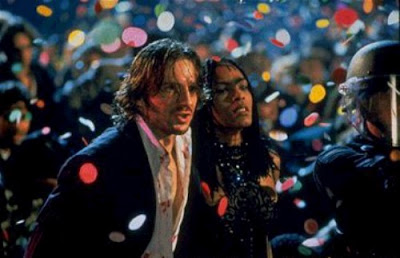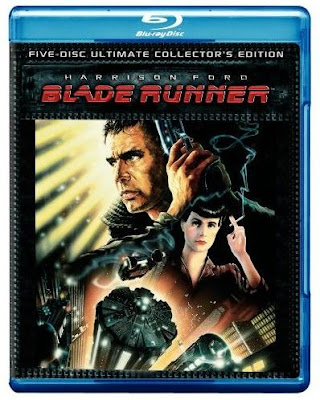 ...and I wish you all the best for 2008
...and I wish you all the best for 2008December 31, 2007
Have a Happy New Year!
 ...and I wish you all the best for 2008
...and I wish you all the best for 2008Not on DVD: WILLARD (1971)
Ironically, half of the films available in horror sections in stores, I wouldn’t recommend to my worst enemy (if I had one). The selection on sale aren’t the best horrors ever made, they simply want you to buy them.
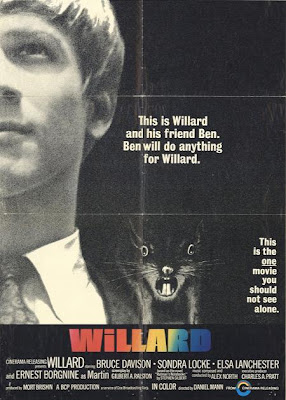
Willard was an early ‘animal attack’ movie, which used to be a very small genre before Jaws swam along shortly after. Beforehand, I can only think of Eye of the Cat, Frogs, Black Zoo, Moby Dick, and Naked Jungle off the top of my head. But rats on the attack are a little more plausible and certainly more horrifying than trying to make pussycats look like killers.
Willard doesn’t have a cast of teenagers - there are old people, some very old, lots of them. The action isn’t non-stop, but slowly and carefully staged, gradually unfolding. Similarly, the violence doesn’t hit you in the face, it serves the story - and doesn’t involve much blood at all. But, you don’t need blood to make a horror film work, just fill a cellar with hundreds of rats…
Based on Stephen Gilbert’s novel, Ratman’s Notebooks, this used to be a well-known horror tale. Young Willard has dreary life full of problems. His ailing mother is practically bed-ridden, he has no friends because he works so hard, he hates his boss and the feeling is mutual… His life is getting worse and worse until a young pretty temp starts working at the office, and he makes a new friend in his back garden – a large brown rat. Feeding and training the rat, who he names Socrates, he discovers that he can effectively communicate with it and it’s growing number of friends.
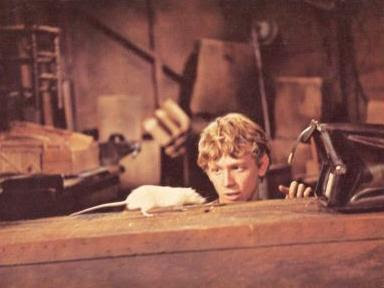
If you like films in pigeon-holes, you could call this a rat-attack movie, but it’s secondary to it’s value as a psychological thriller. The pressures mount on Willard till he cracks, notably from bullying by his boss. But instead of going spree-killing with automatic weapons, he uses the rats to cause trouble, steal, and then attack… all without having to appear in person, almost a perfect crime. The book went one step further than the film by having Willard disguise himself as a giant rat for his night attacks. A headline in the film alludes to this subplot from the novel.
Bruce Davison’s performance is the reason for seeing this now. Davison (who more recently starred in X-Men and X2) is excellent as the nervous mother's boy, resembling a lost teenager rather than a 27 year-old. Usually when actors talk to themselves onscreen it’s because it’s the only way we can hear their thoughts, but Davison realistically portrays someone stomping round a big empty house, ranting to themself.
His mother is played by Elsa Lanchester, then still famous as a ‘horror star’ for having been the monster’s mate in Bride of Frankenstein back in 1935. Ernest Borgnine, halfway between The Wild Bunch and The Poseidon Adventure, believably plays the scheming bully who is Willard’s boss. Sondra Locke is suitably innocent as the temp, but she was soon to make more of an impression in many of Clint Eastwood early movies.
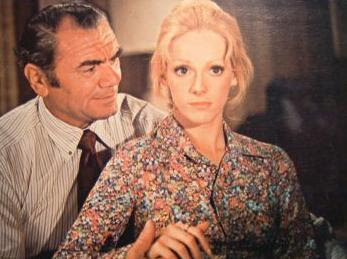
On a sour note, the musical score by Alex North (Spartacus), schizophrenically veers between menacing and cute. As Willard trains the rats, the music sounds more like a Disney real-life adventure. An almost romantic theme over the opening shots of the steel mill (where Willard works in the office), I thought I was watching an advert for the US steel industry.
There’s no real sudden shocks, but even knowing that rats don’t normally attack people and are shy and highly intelligent, seeing lots and lots of rats make me feel very uneasy. There’s no trick photography, just a lot of rats. But they are well-trained, Moe and Nora Di Sesso are credited as the trainers. They also worked on the sequel and trained the dogs in The Hills Have Eyes (1977)! The Humane Association were also on hand to monitor the faked rat cruelty (but where were they on Food of the Gods?), which is just as distressing to watch as the suffering of the human cast.

But why else would this film disappear so efficiently for so long, not even getting a DVD release when the remake arrived. All you can get now a dark, crushed transfer on VHS if you’re lucky.
Willard successfully lead to a sequel the following year, Ben (which I’ll watch again soon). Recently there was the remake with Crispin Glover which is worth a look, but not nearly as memorable. CGI rats…
December 28, 2007
BLADE RUNNER - THE FINAL CUT (1982/2007)
Five-film boxsets include the original US version, the International version, the Workprint (all 1982), the Director's Cut (1992), and the new Final Cut (2007).

Well, wow. It’s about time I talked a little about my favourite film. The perfect opportunity has arisen with the new boxset releases that include a new Final Cut of the film. It's not a review of the film, but thoughts on the new version.
After a delay of five years for legal haggling, the 20th anniversary release has become a 25th anniversary. While the wait has been unbearable, hopefully the extras have had time to be almost perfect! But I was expecting more of a fanfare, aside from all the advertising. The tenth anniversary gained a wide theatrical release, and this version is much more different than the so-called 'Director’s Cut'.
For years I’ve been fuming about the Director’s Cut eclipsing the original International Version that I first saw in 1982 (a much more violent version than was seen in the States). The Director’s Cut lost the violence, the narration and the happy ending. But it was little more than an intermediate edit for the new Final Cut and deserves to be ditched in the scheme of things as little more than a castrated reissue. Of course, it’s now had a shelf life of 15 years and been the only version ever available on DVD, versus the original’s 10 year reign which only made it to VHS panned and scanned, only ever widescreen on laserdisc. The Director’s Cut has been the most seen, but least interesting version. The unicorn shot was the only additional footage, lifted from out-takes from Legend (which was filmed after Blade Runner, fuelling rumours that Ridley had made up the scene afterwards).
I’m obsessed with many films, but this one has preoccupied me the most. It’s so dense, layered in meaning, visuals, music... I love the production design of the film, the cast, the special effects, the accurate-looking future, the emotions, the richness of the cinematography… I could go on.
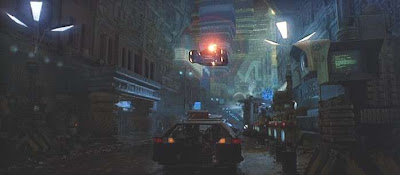
It was released at a time when journalism was starting to provide accurate behind-the-scenes coverage about film production, and here was a subject that deserved to be written about, most notably the Cinefantastique double issue and the Cinefex issue dedicated to the special effects. When the Directors Cut was released, the crucial Video Watchdog article listed the differences between all versions and highlighted the Workprint as being far more interesting – finally we can see that too in the 5-disc disc release.
Entire books have been devoted to the film, best of which was an authoritative expansion of the CFQ article written by Paul Sammon – Future Noir. Though it's likely to have been pillaged for all the best anecdotes to go into the extensive documentary and DVD extras.
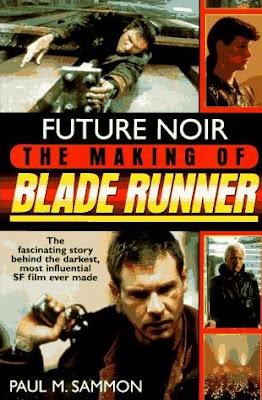
Added to this, along the years, several indepth websites continued to update props whereabouts, interview the cast members, log alternate early scripts, and even post missing chapters from the Sammon book.
So after pouring over images of lost scenes, sounds and anecdotes, we finally get to see an update of the film, with the most annoying special effects and continuity errors of the film corrected digtially. Wire removal now makes the full-size Spinner car fly, a stunt woman in a bad wig has now morphed back into Joanna Cassidy, Deckard’s tell-tale bruise has been removed (it appeared beofre his fight with Leon because a dialogue scene got the number of surviving replicants wrong). Countless other dialogue tweaks in the soundtrack explain the unexplained, yet the much talked about narration remains missing, leaving the film treading water in places. I liked the narration – I miss it’s poignancy as well as background exposition – it still echoes in my memory as the new versions of the film play without it.
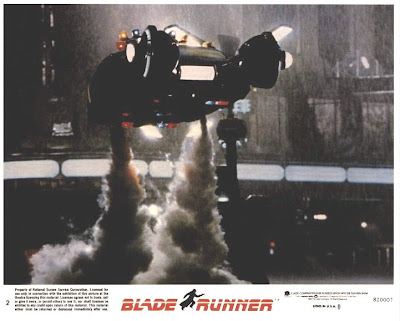
Anyway, hopefully there’ll be no more variants. Besides the fixes, there is little additional footage - three scenes are very different, jarring to someone who’s seen it many times – the unicorn, the dove, the hockey masks...
The whole debate about Harrison Ford’s character, Rick Deckard, being an artificial replicant like the ones he’s hunting down, is a complete red herring, but it's the storypoint that everyone now talks about. Scott fixed it in the Director’s Cut to lead us towards that conclusion (why didn’t he do that originally?). He’s now nailed it in interviews, but in the film the unicorn scene and it's pay-off are oblique references open to interpretation. To me, Deckard is more human than the replicants, he loses every single fight with them, even the pleasure model! The story has him teaching a non-human to love – that scene is meaningless if he too is artificial.

One scene has his eyes subtly ‘glow’ the same way as the replicants – I always thought that was a clever red herring placed halfway through the story to send the audience in the wrong direction. Harrison Ford didn’t play Deckard as artificial, while the other actors take great pains to portray something child-like and different in the replicants. Zhora’s killing machine anger and strength, Pris’s four-year old vulnerability, Leon’s twitchy ignorance, Roy’s race against the clock – all masterly performances of replicants, very different from Ford’s.
The film for me is about the contrast between human and artificial human. The irony, the humour and even the plot falls falls down if he’s one of them too. It’s a cheap twist ending, more abrupt and “huh?” than the original ‘happy ending’ which I prefer. In the Channel 4 documentary, many other members of the cast and crew were equally divided about this point – it should be open to opinion, not ‘fixed in post’.
But now on HD-DVD and Blu-Ray, an impeccable futureproof 4K telecine transfer now gives us a glorious new version to be studied, rendering far more background detail – sometimes too much. Spinners can now be seen flying around in the far distance of the cityscape – an astonishing detail.
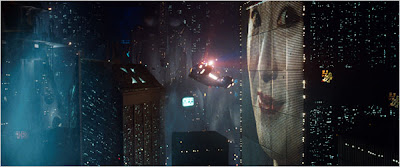
To me there’s little that dates the film. The themes of genetic replication, overpopulation, artificial intelligence, fucked weather, are all as relevant as ever. The vision of a future that will be mucky, wet, and dangerous and that humans will escape and discard the dying planet to look for new ones seems more likely than ever.
For me, the future hasn't arrived until we get flying cars.
Now for the other four discs...
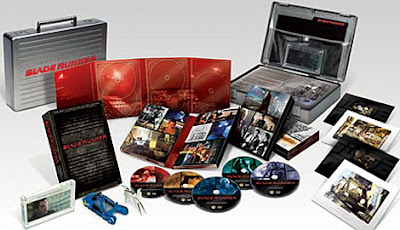
- - - - - - -
December 18, 2007
Christmas is a time for... Cat People!
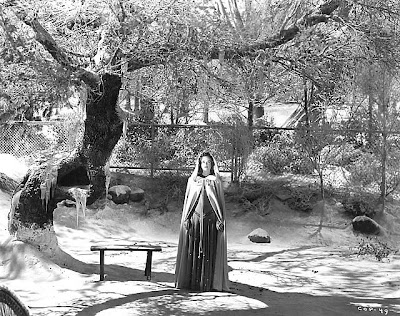
Curse of the Cat People (1944) - a Christmas movie with a difference. Why not invite Irena into your home?
- - - - - - -
December 06, 2007
FREEDOM (2007) - a 21st century Akira

(2007, Japan)
US NTSC region 1 DVD/HD-DVD (Honneamise)
There was considerable excitement that Katsuhiro Otomo, the writer/director of the groundbreaking anime movie Akira (1998), was again heavily involved in a futuristic anime. His last animated movie, Steamboy (2004), failed to catch the same attention, despite a huge budget and long development. Since then he's directed the live-action movie of Mushishi, but is now back on more familiar ground.

Though Freedom is directed by Shuhei Morita (Kakurenbo), the characters, machines and many aspects of the story are heavily reminiscent of Otomo's Akira. While Akira was made with painted animation cels, Freedom is rendered in a complicated 3D computer-graphic process, that eventually looks like the old 2D characters. The project retains the look of traditional anime, and the artists can still express emotions the traditional way, but the characters can interact with dynamic 3D camera moves and backgrounds.
This is all very exciting, but not totally new. The crew that produce Appleseed have achieved similar results, with slightly more realistic human figures. But have now made three movie this way - we are just about to see Vexille and Appleseed 2. It's great to see what looks like a next generation Akira - maybe they could produce a remake this way, rather than in the rumoured live-action?
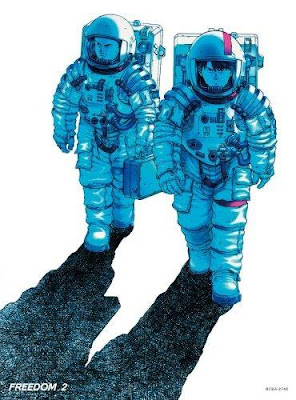
But for me the downside of the Freedom project, having only seen the first episode, is that the story is far from cutting-edge. The animation is magnificent, and the intricately designed moonbase and interiors are a peek into the future 300 years from now, but the characters are pretty standard and the story doesn't hit the ground running. We get action instead. It feels like there's big money riding on this, and the producers are playing safe with the story.
Even the theme tune is a years old Utada Hikaru hit. This is disappointing - good as it is, as I'd expect brand new music for a project like this.
Further disappointment came from the realisation that the action in episode 1 looked very like the pod race out of Star Wars: Episode 1 - The Phantom Menace. The recent anime series IGPX had already done something more exciting in this vein, why doesn't Freedom?
The spectacular pod races dominate the first episode, but have little bearing on the plot. Three teenagers wander around the huge interiors of the moonbase, and out on the surface (in suitably Otomo-styled spacesuits). We learn little more than the Earth is no longer habitable, and that the three young men are always in trouble, probably not heading for citizenship that will enable their freedom in a few months time.

Anime fans in the west will know the anime term OVA, but have rarely encountered it in practice. Original Video Animation, refers to an anime series that is released on video in episodes, funded only by the video sales. We normally have the luxury of purchasing entire OVA series after the Japanese fans have 'paid' for it. We're not used to waiting for the next episode to be animated! The first OVA was Dallos, directed by Mamoru Oshii (Ghost in the Shell) in 1983, heralding a new way that animators could experiment free of network TV confines and censorship, catering for adult storylines.
My first OVA was Blue Submarine no 6, which like Freedom was released in single episodes on DVD in the US. That tale of undersea mutations battling land-dwellers in a flooded world, with then cutting edge 3D vehicles mixed with 2D characters has aged very well, particularly for the vehicle designs, thundering action scenes and challenging storyline - more exciting, it must be said, than Freedom's first episode.
Freedom is a hard sell in the west, only 25 minutes of episode per DVD, without the advantage of the heat of the multimedia publicity campaign that they had in Japan, where a long campaign of TV ads for pot noodles, were set in the Freedom universe. These same Cup Noodle products are also noticably placed in the episodes.
The US DVD release of Freedom episode 1 was unusually ahead of the Japanese launch. It's also on a rare format - a single-sided dual-layer twin format disc that plays in both DVD and HD-DVD players. The extras on the DVD are a preview of episode 2 and an interesting work-in-progress version that can be viewed alongside the finished episode in various configurations - enabling viewers to pinpoint the high number of computer-generated sequences.
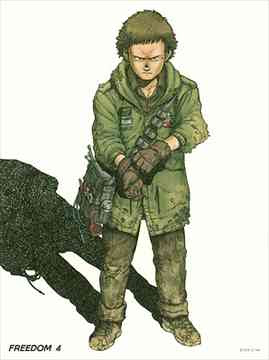
I'll still be getting further episodes. This is superior animation from some of the best talents in Japan, but I was expecting to be really impressed. Hopefully episode 2...
Do you want to know more?
Japanese Freedom website
US Freedom website
English language blog by one of Freedom's animation staff
Books about movies. Yes, books.
I haven't read these yet, but they are already favourites on my bookshelf. When I get round to them I'll tell you more, but I just want to tip you off about these before Christmas strikes.
 CENTURY 21 FX: UNSEEN UNTOLD
CENTURY 21 FX: UNSEEN UNTOLD
For Gerry Anderson and Supermarionation fans, this new book is packed with colour and black and white photos from the behind the scenes of the special effects Century 21 Studios, who worked for the sixties TV productions UFO, Captain Scarlet, Joe 90 and Thunderbirds (including the two feature films).
Author Alan Shubrook worked in the model studios and had just bought a new 35mm SLR camera. His photo collection show some breath-taking moments of classic children's TV being filmed. For example, on the cover, you see Thunderbird 2 taking off. The book is available paperback and hardback.
 QUEEN OF JAPANESE MOVIE
QUEEN OF JAPANESE MOVIE
Queen of Japanese Movie is all about a 'tough-girl' cycle of seventies movies that mixed bad girls with fashion and music in a whole new way. The cycle starts with the Stray Cat Rock movies that launched Meiko Kaji as the ultimate in resilient women anti-heroes, before she became Female Prisoner Scorpion or Lady Snowblood. The genre simultaneously promotes women as resourceful survivors, at the same time exploiting them erotically. While some characters could be feminist role-models, they also spend a little screentime topless - the photos in the book reflect both aspects of the films...
Although mostly in Japanese, there are English synopses as well, but the majority of the book is colour photos and posters from the films. A great way to navigate the next wave of vintage cult Japanese cinema to hit the west. The book also contains a CD of music from the movies.
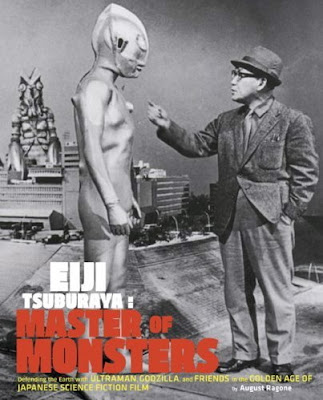 EIJI TSUBURAYA: MASTER OF MONSTERS
EIJI TSUBURAYA: MASTER OF MONSTERS
American author August Ragone spotlights the special effects maestro who first brought Godzilla to the screen, as well as pioneering the TV studio that brought us, and still brings us Ultraman. The photo on the front is of him working on the very first episode, back in 1966. The book is heavy on photos, and is already selling well. Good to see Tsuburaya-san finally getting more recognition.
Although Eiji Tsuburaya is no longer with us, his legacy is still going strong - his film and TV work continues to be released on DVD, and the characters he brought to life are constantly being revived. In 2004, I was lucky enough to visit a museum in his home town that celebrated his work and the fiftieth anniversary of Godzilla films.
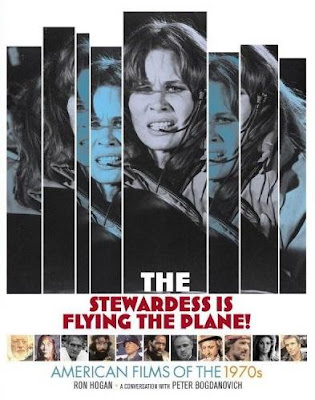 THE STEWARDESS IS FLYING THE PLANE!
THE STEWARDESS IS FLYING THE PLANE!
This was actually published in 2005, but I've not heard enough praise about it. Again it's heavy on photos and posters, focussing on the most entertaining US movies of the seventies. The text is a mixture of information and irreverant interviews designed to remind you or inspire you of the best and funnest movies of the decade.
The title is of course a line of dialogue from Airport 75, a classic and silly disaster movie that almost sent itself up before Airplane got to it. The book is an easy read, a great volume to dip into, and the photos are rare enough for even collectors of the genre.
- - - - - - -
November 30, 2007
The HAUNTED SCHOOL (2007) - annoying Hong Kong horror
Region 3 Hong Kong NTSC DVD (Joy Sales)
A meaningless barrage of screams, spooky noise and a muddle of images under the title sequence indicate where the film is going from the start.
Someone or other dies and curses the school (all these hangings keep reminding me of Lucio Fulci's City of the Living Dead, which kicks off with a priest sinning by suicide - now there's a horror film) with a curse that's even simpler and sillier than Friday the 13th - basically 'don't fall in love'. Guess what, the school's just gone co-ed. Four young men arrive in an all girl's school, with the teachers, and an angry ghost trying to keep them apart.
Shot on video, with very electronic special effects isn't the problem, though the ease of electronic editing is overused. My main complaint is really the lack of storytelling. Too often we see meaningless parade of exterior shots, spooky sounds, all while the story's going nowhere.
Volume is blasted up for no reason other than to scare, because the story isn't scary. I mean, it could have easily been called the Haunted Toilet, so much of the 'action' takes place in there!

Producer Andrew Lau (director of the Internal Affairs trilogy and Initial D - The Movie) has obviously the technology to make endless low budget movies - but he's short of scripts and scary horror isn't easy. Using the tested ploy of recruiting a cute cast, and designing a cool poster, plus slapping his name on the credits as a clincher. It worked on me, and I bought the DVD - but I won't be stung twice. If I'd known it was actually a film by the director of Devil Eye I'd have kept my HK dollars...
Granted there are a couple of inventive, but unscary ghost scenes, involving, surprise, a long haired ghost, and some laptop computer fx.
The English subs are OK, and there's an anamorphic picture, and DTS sound. But little within to actually entertain.
November 29, 2007
MADCHEN IN UNIFORM (1958) - remake of the classic

Germany, 1958
German region 2 PAL DVD (Galileo)
I was searching for DVDs of the 1931 version of Madchen in Uniform (recently reviewed here), when I discovered this colour remake was already out. The 1931 adaption of this rather brave German novel was about the relationship between a teacher and a student at a girl’s boarding school. It dealt with lesbian characters in a matter-of-fact way that’s commendable even today. Though the 1958 version appears to be slightly cagier about the relationship. It's still a very early example of the sympathetic portrayal of lesbian characters.
It tells almost the same story, but the characters are less innocent about the matter, and recognise that a same-sex relationship means unheard of scandal. Everyone senses that lesbian love is dangerous to admit to, and panics accordingly. The original film was less judgemental because it was skirting the issue more, and became more romantic as a result. In black and white, it also looked more beautiful. The colour version has a tough time making the boarding school look drab, dressing the sets and all the girls in grey.
There’s a better sense that everyone is trapped in the school, within high walls, iron gates and bars on the windows. The headmistress is made of iron too, iron willed, unrelenting in her quest for discipline as the ‘be all and end all’ to the country’s problems (set at the turn of the century). Her tough stance, set against the schoolteacher’s progressive, ‘firm but fair’ attitude is the story’s strength, and the conflict is more energetically debated and dramatically dealt with, than the earlier film.
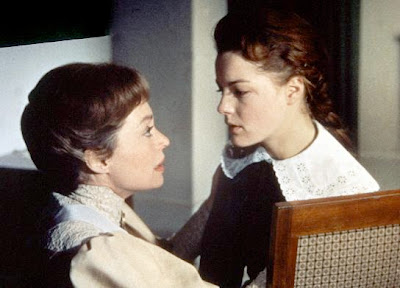
The romantic relationship seems less scandalous between teacher and student because there is less ambiguity about it. The girl, Manuela, is besotted with her teacher, and definitely in love with a woman. But her teacher, Elisabeth, has been misunderstood, and has more of a motherly love for all her pupils. This dodges the issue somewhat, but clarifies the teacher’s character. The scandal however remains and leads to an exciting, but not necessarily fulfilling, climax.
It’s interesting to contrast the two films, but I still need to read the novel before assessing if either film has been faithful. The 1958 version is very accessible and still looks like a modern production. The cast is superb, with Therese Giehse especially fearsome as the headmistress.
Lllli Palmer, as the teacher, is always good at playing strong characters, and has acted in German and English. Born in Prussia, she appeared in British films as early as 1936 (after fleeing the Nazis early on), but later returned to live in Germany before finally settling in the US. She notably appeared as an overtly lesbian schoolteacher in The House That Screamed (La Residencia), a marvellous Spanish horror film that I’ve already written about. It appears to be a ‘riff’ on her role in Madchen. You might also have seen her in The Boys From Brazil (1978).
But it’s Romy Schneider who shines here, and is still mourned in Germany as one of their most beloved actresses. She passed away at the age of 45, ironically even before Lilli Palmer. Her roles are so full of life, even in the English language comedy, What’s New Pussycat? (1965), a sexy romp (scripted by Woody Allen) where she is trying to marry Peter O’ Toole and tear him away from his busy life of bachelorhood.

This German DVD (pictured at top) marks almost fifty years since the film was made. The print was obviously in fairly poor shape, as a lot of electronic restoration has made the picture a little smeary in places. But the bright colours compensate and the soundtrack is very clear. The picture aspect is an acceptable 4:3 and the English subtitles are very readable, but don’t always translate visible text. The only extras are five other, quite racy trailers for Romy Schneider films that are also available on DVD. Amazon.de is a good place to find all of them.
November 27, 2007
Cult movies already available in High Definition
Some releases are shorter on extras than their DVD counterparts, but these formats mean that, on the right home video equipment, you can enjoy these films in better quality than they were ever seen in the cinema, with sharper pictures and cleaner sound. A far cry from the grainy scratchy prints we get in the UK (after they've played a dozen cinemas in the US) and the old monophonic sound systems of pre-multiplex cinemas where you couldn't even make out the dialogue (I still don't know the plot of the original Gone In Sixty Seconds...).
I'd love to cover these films at length when I watch them again, but for now, here's a quick look around. The 1980's are being better represented than the 1970's so far, but some of my favourite 80's films are already out there...
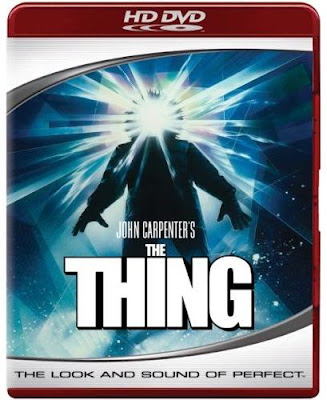
THE THING (1982)
HD-DVD
John Carpenter's remake of The Thing from Another World (1951) is a must-see - certainly his most shocking film, featuring the bizarre and imaginative mutating alien creature. Carpenter's original Halloween is also out on Blu-Ray, and The Fog is out on HD-DVD.
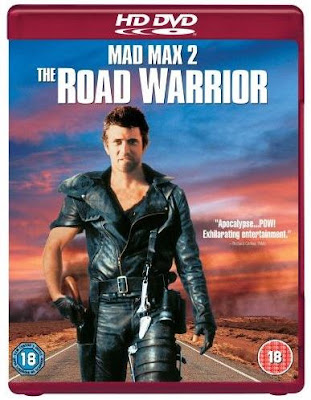
MAD MAX 2 - THE ROAD WARRIOR (1982)
HD DVD and BLU-RAY
My favourite Max movie, featured a more modest Mel Gibson as the hero of this trendsetting, post-apocalyptic epic. Called Mad Max 2 in the UK and Australia, but The Road Warrior in the US (where the first Mad Max had made less of an impression). Classic cinematic storytelling, gruelling stunt-heavy action, and one of the Coen Brothers' favourites too, as influential as The Evil Dead on their bonkers comedy Raising Arizona. Mad Max director George Miller has since found far easier and lucrative films to make... about talking, dancing animals... aargh!

John Landis also peaked with this film, a no holds barred horror, that also works as comedy and a snapshot of life in Thatcher's Britain. Again the intricate special effects were achieved on set (like most of The Thing), meaning that there are no ultra-grainy opticals for HD to highlight.

TWILIGHT ZONE - THE MOVIE (1983)
HD DVD and BLU-RAY
This compendium sci-fi fantasy remake of sixties TV episodes has thus far been missing from even DVD. Again the special effects are largely staged on set, thanks to Rob Bottin's creations and make-ups. Each segment had a different director: John Landis made the ill-fated role-reversal opener. Joe Dante remade the episode 'It's A Good Life' with mad cartoony monsters, in-jokes and a pre-Bart Simpson Nancy Cartwright. Steven Spielberg submits the dullest and most schmaltzy segment, then George Miller saves the day with the barnstorming remake of 'Nightmare at 20,000 Feet'.
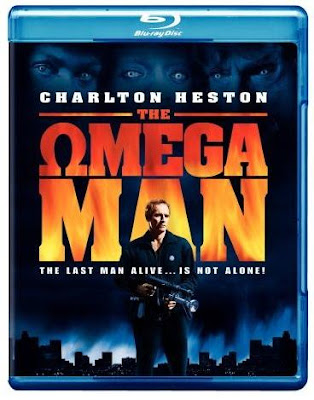
THE OMEGA MAN (1975)
HD DVD and BLU-RAY
Thanks no doubt to the third filming of Richard Matheson's I Am Legend hitting cinema screens, it's good to see my favourite adaption so far get a release. Starring Charlton Heston as Robert Neville in a deserted L.A., this adaption strays from the novel, but in an interesting direction. It also had a poster declaiming that "The last man alive... is not alone". Credit due...
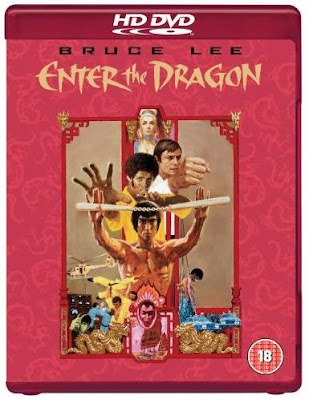
ENTER THE DRAGON (1973)
HD DVD and BLU-RAY
The most famous example of Bruce Lee on film has a very James Bond plot. It'll be a pleasure to see this given a quality presentation.
The high cost of producing High Definition discs currently prohibit many smaller cult films getting out on HD, and may prohibit titles from the far east getting re-released in the west. There are exceptions, and thankfully, some Asian HD releases already have English subtitles.
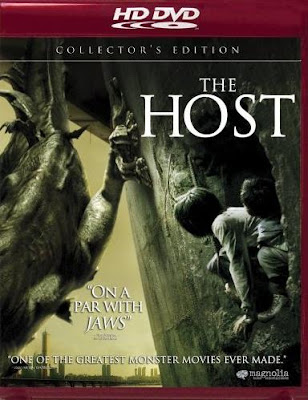
THE HOST (2006)
HD DVD and BLU-RAY
This has had a release in the UK and US, and the movie was very carefully mastered with HD in mind. This monster should stand up to very close scrutiny! How many other South Korean films make it to HD is another matter, though D-War has been announced for January.

HD-DVD / DVD twin standard
The hardware and character designs in this futuristic adventure are by Katsuhiro Otomo, the director of Akira, no less. If you want to wait a few years, you will get eventually see all six episodes in one boxset - personally, I'm not going to wait. The director, Morita Shuhei, previously made the fascinating short film Kakurenbo - Hide and Seek.
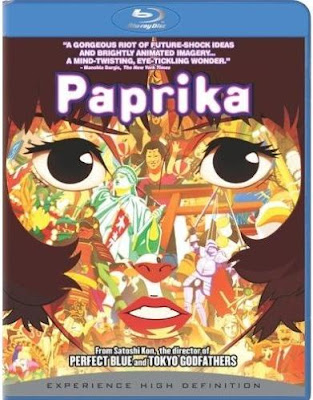
PAPRIKA (2006)
Blu-Ray
Satoshi Kon's (Paranoia Agent, Millennium Actress) new feature is out on Blu-Ray in the US. I'll wager that more anime films get released than any live-action from Japan and the Far East. Tekkonkinkreet is also newly out on Blu-Ray in the US.
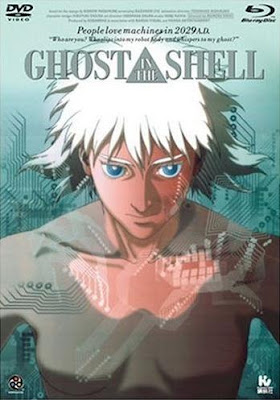
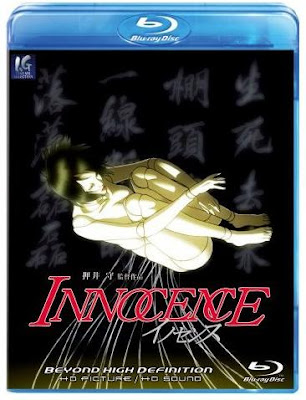
GHOST IN THE SHELL (1995)
GHOST IN THE SHELL 2: INNOCENCE (2004)
Blu-Rays released in Japan
Meanwhile, in Japan, both Ghost in the Shell feature films are out on Blu-Ray with English subtitles. The discs aren't cheap, but they're out there. If only a few Japanese films get a US HD release, hopefully their Japanese releases will still cater for English audiences this way. Getting the information about whether Asian discs have English subtitles on them is difficult though. For instance, CD Japan hasn't been as reliable as usual about listing this information, so it's worth checking several sites. They do however have a special HD section mostly full of films from the US.
Another major consideration in this information minefield is the new region-coding map for Blu-Ray, which is NOT the same as the old DVD regions. America is now compatible with SE Asia, including Korea and Japan (but not China). Early releases didn't have this coding, but new discs won't play in your Blu-Ray player if the code is different. HD-DVD discs don't have any region coding.
In Hong Kong, the big budget, high-flying, swordplay costume dramas, like House of the Flying Daggers, are obvious choices for HD, but we didn't even see any HD players for sale in Hong Kong in July! So it's a pleasant surprise that Initial D - The Movie (2005) is getting a Blu-Ray release. But is that a Region A or Region B disc though? I guess they count as China now. Like I said, international shopping continues to be a bit of a minefield.
November 26, 2007
CARVED - THE SLIT-MOUTHED WOMAN (2006)
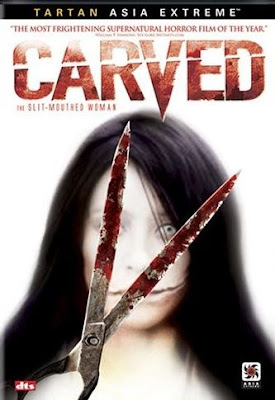
I was looking forward to this one – I didn’t think such a strong urban legend could possibly fail to frighten. A murderer with her face slashed open (echoes of The Man Who Laughs and Mr Sardonicus) with a huge pair of scissors to inflict a similar fate on her victims.

But instead of gory fun, we get a series of rather realistic child beatings. I’d imagined that any children in the story were just going to be frightened by her hideous appearance, but never actually harmed. It’s not very gory, but the suffering of the adults is far less fearsome than the extent of the child cruelty.
This makes the film nasty rather than entertaining – the issue of child abuse is worth exploring and explaining, but not in a horror film, where the problem is shown without any realistic resolution.
Similarly, the plot is very weak. A kidnap victim suddenly spots some broken glass to cut their bonds with, after it's been sitting in front of them for days. The heroes accidentally murder someone without any trouble from the police. The neighbourhood children have an endless supply of accurate information about the slit-mouthed woman, while the police don't. Even the mystery of the monster is wrapped up more simply than a Scooby Doo episode, with the viewers at least half an hour ahead.


The monster also has an array of powers, far more complicated than necessary, and mostly unexplained. The flashback story is rather feeble, explaining little more than the way she's dressed. Such a fearsome character deserves a sequel, with a better origin story and more adult victims, please.
So, too much kicking and stabbing of helpless victims, and not enough plot. It’s watchable enough for the performances and the bizarre title character, but I wanted it to have been so much better.
Director Koji Shiraishi has previously delivered Jurei – The Uncanny (which was OK) and Noroi - The Curse.
Eriko Sato, the mischievous star of the recent live-action Cutie Honey movie, is unrecognisable as a harassed, mousey schoolteacher.
The DVD subtitles are a little awkward in places, and the American title of Carved is a misleading one, making the film sound more like a Hostel/Saw/Hatchet job, rather than a yokai story.
I fear this film might be too much for a release in the UK. I wouldn’t be surprised if the British censor only passed this with extensive cuts, particularly with so much child murder in the headlines at the moment.
November 22, 2007
THE LOST WORLD (1962) - finally on DVD, with all the frills...

plus THE LOST WORLD (1925)
The last version of The Lost World to reach DVD is also the first version I ever saw. This DVD will be the first opportunity to see it in 2.35 widescreen on home video. The dinosaurs are played by lizards with frills stuck on, Claude Rains plays the shortest ever Professor Challenger, and this is the only version of the classic novel to heavily feature a poodle.
Director Irwin Allen was about to enjoy a successful decade of classic children's TV, starting with Lost In Space and Voyage to the Bottom of the Sea, before having a disastrous decade of movies with The Poseidon Adventure and The Towering Inferno. For all their weaknesses (usually in the acting and realism departments), I can't get enough of his work.
Strangely, an alternate restoration (to any previous release) of the original silent movie version of The Lost World (1925) is also included. This version is definitely worth a look because it's essentially a dry run for the 1933 King Kong - the pioneering special effects were by Ray Harryhausen's mentor, Willis O' Brien, who worked on both films.
More about the many releases of the silent version of The Lost World can be found here...
November 19, 2007
THE GREAT HORROR FAMILY (2004) Takashi Shimizu's TV sitcom
(Japan, 2004)
Region 1 US NTSC DVD series boxset - 13 x 25 minute episodes (Bandai Entertainment)
The cartoon cover art for this DVD set is very misleading, because this is actually a live-action series, a comedy horror show from the creator of The Grudge movies, Takashi Shimizu. He thought up the series and directed the three closing episodes.
This is also one of the few Japanese live-action tv series, (besides the tokusatsu Ultraman and Power Rangers) to be released on DVD in the west. It’s a typical example of Japanese TV shows – low budget, and shot on video. It’s also a curious choice, compared to many other more impressive TV shows.

Besides wanting to be known for something other than chillers, Shimizu started getting ideas about what could be funny about haunted houses, while he was making his horror films. This is most obvious in the early episodes, which contain many references to The Grudge, particularly the long black-haired ghost and her creaking joints. Toshio, the little ghost boy makes a fleeting appearance too.

Kiyoshi and his living dead girlfriend
But the story is of a family moving into an extremely haunted house. Grandpa can sense the spirits immediately, but unfortunately joins them when he too passes away. He awakens the power of psychic awareness in his grandson Kiyoshi, whose job it becomes to protect the family from the many spirits living and arriving at the house. One running joke is that the traditionally wise head of the family, grandpa, is forgetful and keeps losing his train of thought.

Kiyoshi’s dad wants to believe in spirits and UFOs but has no psychic ability at all. His mother, grandmother and sister are all slightly psychic but are so preoccupied that they keep missing the various hauntings. The dog is just there to look cute.
The comedy is broad, the horror is fairly limited, but there are plenty of ghosts and (cheap) yokai monsters. Obviously I missed out on many of the in-jokes, but I enjoyed Kiyoshi’s bumbling character and his kitchen-obsessed mother.

Issei Takahashi as the hapless Kiyoshi
The special fx are pretty basic, occasionally impressive, but usually plain silly.
I was more impressed with the less comedic episodes. The scenario had dramatic possibilities that I thought worked better than the comedic ones. Episodes 5, 6 and 7 had some grim touches as well as touching moments, of the living interacting with the dead. Grandad meets the ghost of a lost love, a gothic schoolgirl is desperate for friendship, and the best story, a zombie bar where the living can have fun with the dead, was an original and nightmarish concept.
The final episodes of the series bring the storyline to a climax, with an over-ambitious time-travel ending where the regular cast members play impressive dual roles.
The series is more interesting than enthralling, and sometimes even funny. But I wished that it had been lighter on the broad comedy.
The generous DVD extras are overlong, but the interviews with Shimizu, and the other three directors, remind us that we don’t often get to hear from him, despite his huge recent horror output. If his English was better, we’d be sick of him pushing his movies on talk shows.
The programme was made 4:3, and is subtitled in English. The boxset contains all 13 episodes from the series.
- - - - - - -
